I visited Fort Gaines 4 times during my stay on Dauphin Island, and have already written about the first 3 of these visits, but due to the number of pictures I had for the other parts of these days and for continuity, I will post all the pictures here.
 The first time I saw the fort was on the night I arrived on the island. As I walked around the island, the sun was waning as I approached the fort. The first night of the SeaGrass Festival was in full swing when I approached the fort. I walked around it, enjoying the fresh sea breeze, checking out the fort, the off shore oil platforms, and enjoying the bluegrass tunes of Three on a String, emanating over the walls of the fort. Along the way, I also checked out Battery Terret, which was built adjacent to the fort between 1898-1903 to supplement the fort's defenses.
The first time I saw the fort was on the night I arrived on the island. As I walked around the island, the sun was waning as I approached the fort. The first night of the SeaGrass Festival was in full swing when I approached the fort. I walked around it, enjoying the fresh sea breeze, checking out the fort, the off shore oil platforms, and enjoying the bluegrass tunes of Three on a String, emanating over the walls of the fort. Along the way, I also checked out Battery Terret, which was built adjacent to the fort between 1898-1903 to supplement the fort's defenses.
The next morning, I returned to the fort, since I had been told by several people that it would be open for normal tours in the morning, before the show. Unfortunately, that was not the case, but I took a few extra pictures while I was there.




 When I returned to watch the SeaGrass Festival, I got to see the inside of the fort at night. With the festival happening, the upper levels of the fort were blocked off, and most of the buildings were being used by vendors, limiting access, so I only got to see a little of the fort, but it was a neat experience, being inside it at night.
When I returned to watch the SeaGrass Festival, I got to see the inside of the fort at night. With the festival happening, the upper levels of the fort were blocked off, and most of the buildings were being used by vendors, limiting access, so I only got to see a little of the fort, but it was a neat experience, being inside it at night.While I had gotten to see some of Fort Gaines during the SeaGrass Festival, I wanted to see the rest, and to see it in the daylight.
This time, as I walked in, instead of being able to walk straight into the fort from the sallyport as I had the prior night, people were routed into the gift shop, located in the guardhouse, to buy their ticket, before heading out the gift shop door that opens onto the parade. During the concert, the walls were closed, so as I walked into the parade, I turned to the right, and headed up the south gun ramp to the southwest bastion. This bastion was retrofitted a concrete observation tower that was part of a 1898 addition to the fort which included three 6-inch disappearing naval guns, three rapid fire 3-inch guns, their corresponding concrete gun mounts, and ammunition magazines.






Moving along the wall, you come to the other two disappearing gun platforms. Rounding the corner of the northeast bastion is the north flank, just off of which is the 3-inch rapid fire battery. You can also look down at the bench style latrine.
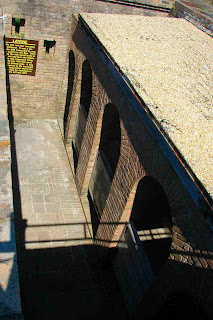


At the tunnel course, you can take the second gun ramp back down to the parade ground, take a set of steps next to the bakery, or continue into the northwest bastion - the only completely original and in tact bastion of the fort, which has a winding staircase down.
After returning to the parade ground, I reversed course, circling it clockwise, rather than the counter-clockwise route I took on the wall. I walked into the bakery, which housed a 12 foot oven and a smaller oven, walked the hallway to the latrine, then looked at the blacksmith shop, which forms the other wall of the hallway. Underneath the two hiding gun mounts is a modern powder magazine, which had a track system on it's ceiling to move the heavy ammunition. In these rooms are also some remnants of shipwrecks that have been found near the island.



Next to the coastal battery are the quartermaster's offices, which were used to store fort supplies like uniforms, and for the quarters of the quartermasters. Emerging from the other side of the quartermaster's offices, we are now at the entrance to the 2 powder magazines that could be seen from on top of the wall. These are located on either side, in front of the solitary hiding gun platform. Next to the platform is a museum. I'm not sure exactly what it was originally used for, but it was part of the concrete structure, and has a few rooms, so I'm guessing it was used as store rooms.




The officer's quarters are located on the south end of the parade. This building, which was originally three stories tall, had the upper levels destroyed during the battle of Mobile Bay. Behind it is a kitchen courtyard, consisting of a couple of cisterns and a few fireplaces, which is where most of the meals at the fort were prepared.
Finally, walking back toward the sallyport, I passed the restrooms, which, of course, weren't originally restrooms, but the orderly room and the commandant's office. This took me back to the guardhouse/gift shop. Next to it is a stairway leading to the top of the wall above the sallyport. I climbed up to find the flag pole and to look down at the gate. Returning back to the gift shop, I had completed my tour of Fort Gaines.
Hello Mississippi! - The Shed Barbeque
 After finishing my tour of Fort Gaines, it was time to get back on the road. I stopped off in Ocean Springs, MS, to try out a barbeque joint featured on Food Network's Diners, Drive-Ins, and Dives called The Shed. It's located just off I10, adjoining a RV park on a bayou. The structure was originally formed around a couple of food trucks, to which various salvaged materials like aluminum siding and other scrapyard items, decorated with license plates, random signs, and the other sort of stuff you'd expect from such a place.
After finishing my tour of Fort Gaines, it was time to get back on the road. I stopped off in Ocean Springs, MS, to try out a barbeque joint featured on Food Network's Diners, Drive-Ins, and Dives called The Shed. It's located just off I10, adjoining a RV park on a bayou. The structure was originally formed around a couple of food trucks, to which various salvaged materials like aluminum siding and other scrapyard items, decorated with license plates, random signs, and the other sort of stuff you'd expect from such a place. As you walk up to the main order station, you notice off to the side, the restaurant's barbeque pit - an old truck that has had the engine bay transformed into a barbeque. I ordered my food - a combo plate of pulled pork and brisket, then found a place to eat in the open-air seating area by the water.
The food was good. Kind of an average portion size for a barbeque joint. It wasn't the best barbeque I've had, but I enjoyed it, and I liked the atmosphere, which is very unassuming and serene.
Biloxi/Beauvoir
I continued on I10 to Biloxi. Driving by the lighthouse, which is in a very odd location for a lighthouse - the median of US90, which runs along the shoreline, but the lighthouse is much further inland than usual. Lining US90 are also several carvings done by a local artist.
I followed US90 to Beauvoir, Jefferson Davis' last home. The house was originally built by James Brown (not that one) between 1848-1852. It's second owner, Sarah Dorsey, gave it it's name after looking out the front porch at the Gulf view, as the name Beauvoir is French for beautiful view. Jefferson Davis started buying the home from Mrs. Dorsey, a family friend, before she died, when he ended up inheriting the balance of it and her property.
Beauvoir was hit pretty hard by Hurricane Katrina, but much of the furnishings were preserved or have been restored, as has the main house. Additional buildings around the property are almost all reproductions. It is a beautiful home, decorated with 19th century furniture and restored painted ceilings and doors. It's well worth visiting, though I think they are charging what they should once the rest of the property is reconstructed.
Hello Louisiana! - New Orleans at Night
I didn't want to limit my exploration of Mississippi to the coast, but because of it's geography, I made plans to go through southern Louisiana prior to going to the west side of Mississippi. This took me almost directly to New Orleans, where I arrived as night fell. I had been in New Orleans after Katrina to help the retailer I worked for at the time to get some of their stores functioning properly, and during that time, I had seen much of the damage that had been done to the city and spent a few nights in the French Quarter, so it wasn't a completely new experience for me.
When I was there before, though, the nightlife that New Orleans is famous for hadn't fully rebounded. This time, it had. I parked on the other side of the river and took the free ferry to the city. Walking around, it felt vary familiar, but more vibrant. There were musicians playing in the streets, all sorts of clubs and restaurants that could be visited late into the night, and tons of pedestrians all over, most of whom were heavily intoxicated.
After walking a while, I headed back to the ferry, wanting to make sure I got there before their last run of the night, so I wouldn't have to walk the bridge to get to my car.





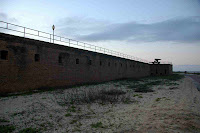







































































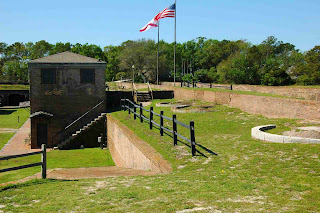














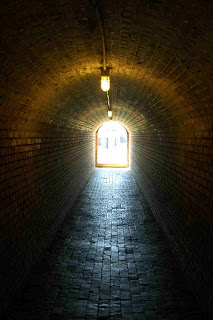







































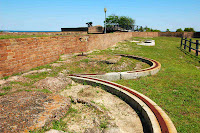




























































No comments:
Post a Comment